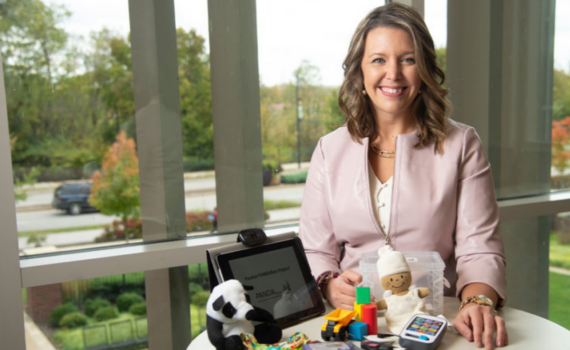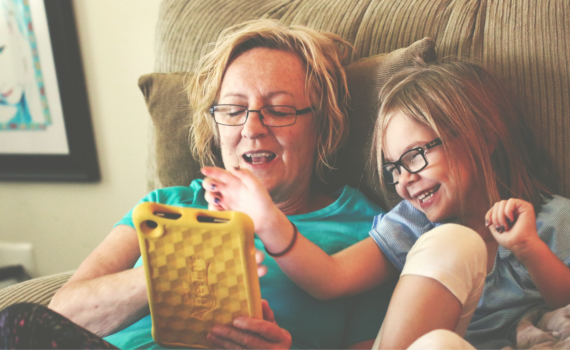
Research Round-Up #7
Bringing the Laboratory Home: PANDABox Telehealth-Based Assessment of Neurodevelopmental Risk in Children
Collecting data on children with neurodevelopmental disorders can be difficult considering the time and cost of researchers traveling to their home. To combat this, researchers developed the PANDABox (Parent Administered Neurodevelopmental Assessment), which allows caregivers to facilitate a home-based assessment to monitor early developmental features and collect lab-grade data on children’s behaviors and biomarkers (see photo above). To measure the effectiveness of the PANDABox, 16 infants with Down syndrome (DS), aged 5 to 19 months, and their caregivers participated in this study. Caregivers were sent the PANDABox, which contains a computer, two heart rate monitors, a webcam, two vocal recorders, and a variety of task materials. The caregivers conducted a series of tasks with their children to provide data that measures behaviors relevant to early clinical risks. During the assessment, the caregiver used a secure teleconferencing and remote connection software to stay connected with the research assistants. This allowed the research assistants to observe, control the computer, and troubleshoot any difficulties during the assessment.
Overall, the PANDABox was well-received by families, with caregivers reporting their satisfaction level as “good” or “excellent” on 97% of post-assessment survey questions. It was effective in generating high quality clinical and behavioral data, with 94% of data being acceptable. The results of this study suggest that caregiver-facilitated assessments such as PANDABox could be helpful for increasing the engagement of caregivers and children in research studies.
A comparison of functional academic and daily living skills in males with fragile X syndrome with and without autism
Daily living skills and functional academic skills can contribute to the development of independence for individuals with fragile X syndrome (FXS) and autism spectrum disorder (ASD). In this study, researchers measured daily living skills and functional academic skills across age groups and compared these skills to levels of independence. In addition, they analyzed and compared the levels of adaptive behaviors in individuals with FXS and individuals with both FXS and ASD. Using a parent survey, researchers gathered data about independence, daily living skills, and functional academic skills in 534 males with FXS or FXS + ASD. The individuals with FXS or FXS + ASD ranged in age from 5 to 67 years old. To measure independence, parents were asked questions such as where their child is living, who they live with, and if they are employed. Parents rated their children’s daily living skills in the topics of hygiene, cooking, laundry and housekeeping, transportation, and safety. In addition, parents rated their children’s functional academic skills in the topics of time and schedules, money, math, reading, and writing. For these individuals, certain skills such as identifying numbers and recognizing their name were mastered at an early age, while other skills such as telling the day of the week and understanding money developed in adolescence and adulthood.
Overall, the data collected shows that many males with FXS display increased daily living skills and functional academic skills by the time they reach adulthood. Males who had only FXS had higher levels of functional academic skills, daily living skills, and independence compared to those with both FXS and ASD. Results also suggest that learning and mastering adaptive skills can lead to independence regardless of ASD diagnosis; therefore, including adaptive skills in FXS treatment could be beneficial for fostering independence.
Maternal Input and Child Language Comprehension During Book Reading in Children With Down Syndrome
Shared book reading between parent and child is helpful for strengthening language and literacy skills, especially for children who are at risk for language delays. Researchers in this study were interested in seeing how mothers of children with Down syndrome (DS) and mothers of children with typical development (TD) differ in communication and language during shared book reading with their children. In addition, they analyzed the relationship between maternal expressive communication and child receptive language. Participants included 22 children with DS and 22 children with TD, all ranging in age from 22 months to 63 months. Development, receptive language, and expressive language were measured and videos of the assessments were coded to quantify maternal and child utterances.
Results showed that children with DS used more nonword vocalizations and gestures and were less intelligible when speaking compared to children with TD. Children with DS likely used more gestures to compensate for their difficulty with spoken communication. Mothers of children with DS used more questions and prompts rather than reading the book verbatim compared to mothers of children with TD. When analyzing the relationship between maternal expressive communication and child receptive language, they found that the higher the child’s receptive language score, the less utterances their mother used. The results of this study were useful in identifying the similarities and differences of children with DS, children with TD, and their mothers’ methods of communication during shared book reading. Researchers suggest using shared book reading as a part of early intervention could be helpful in supporting vocabulary and strengthening literacy skills.














